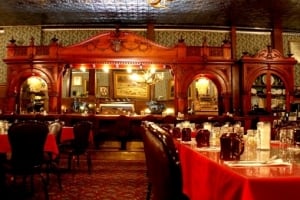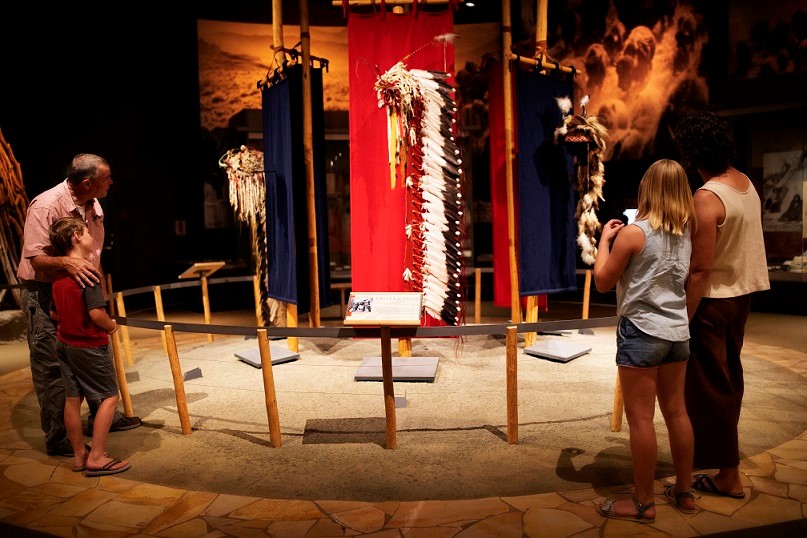
#That’s WY Cody Will Be a Top Destination for History Lovers in 2021
CODY, Wyo., Sept. 14, 2020 – The small town that Buffalo Bill Cody built will turn 125 in 2021, and history buffs are expected to travel to Cody to experience the array of attractions that showcase Buffalo Bill’s life as well as many other adventures that define this rugged northwestern Wyoming region.
“Exploring Cody’s proud and authentic history is an important part of a modern-day adventure here, and visitors can experience that authenticity in many ways,” said Claudia Wade, director of the Park County Travel Council, the marketing arm for Cody Yellowstone, a region that includes the towns of Cody, Meeteetse and Powell as well as the valley east of Yellowstone National Park. “From Buffalo Bill’s embroidered, fringed Wild West Show jacket on display in the Buffalo Bill Museum to the Cherrywood bar at the Irma Hotel, our culture is forever linked to our visionary founder, Buffalo Bill Cody.”
The town’s story began in 1896, when Col. William F. “Buffalo Bill” Cody had a good idea. By that year, the 50-year-old Cody had already earned his famous moniker in a bison-hunting contest. He’d already become the most famous man in the world when he played himself in “Buffalo Bill’s Wild West Show.” His life had already inspired a series of dime novels about the American West. He’d already been a trapper, bullwhacker, Pony Express Rider, Colorado “Fifty-Niner,” wagon master, stagecoach driver, Civil War soldier, hotel manager and scout for the U.S. Army.
What was left for a man who’d lived such a robust, accomplishment-filled life? Some of us might consider early retirement or find a hobby. Not Buffalo Bill Cody. Inspired by the undeveloped region’s combination of scenery, wildlife and rich soil as well as its location 52 miles from Yellowstone National Park, Buffalo Bill Cody decided to build a town.
There’s a great deal more than Buffalo Bill Cody lore as well. Cody Yellowstone is home to numerous museums and attractions that showcase the one-time frontier town’s sometimes raucous, sometimes heartbreaking, often innovative past.
Travelers planning a visit to Cody Yellowstone can request a free vacation guide and find a variety of online tools listing lodging and attraction options.
Here are just a few ways history buffs can expand their knowledge and experience the authentic history of Cody Yellowstone next year:
Collections of tribal artistry at the Plains Indian Museum, one of five Buffalo Bill Center of the West museums. This acclaimed museum includes creations of many Plains peoples such as eagle feather bonnets, bear claw necklaces, buffalo hide tipis and tipi furnishings, shields, cradles, peace medals and moccasins.
The Visitor Center at the Buffalo Bill Dam. Once the tallest concrete dam in the world and a National Civil Engineering Landmark, the Buffalo Bill Dam was operating before Buffalo Bill Cody’s death in 1917. The visitor center’s exhibits show how the dam fulfilled the forward-thinking showman’s goal to bring a reliable water source to the Bighorn Basin.

England’s Queen Victoria gifted the Cherrywood bar at the Irma Hotel to Buffalo Bill Cody.
The Cherrywood bar at the Irma Hotel. Cody built the Irma Hotel in 1902 and named it after his youngest daughter. Listed on the National Register of Historic Places, the hotel’s famous room-long Cherrywood bar – still in use today in what is now the hotel dining room – was presented to Buffalo Bill by England’s Queen Victoria, who was charmed by Buffalo Bill and his Wild West Show when the company performed in London.
“Buffalo Bill – The Scout” at the Buffalo Bill Center of the West. Created by famed New York sculptress Gertrude Vanderbilt Whitney, The Scout has greeted visitors to the Buffalo Bill Center of the West since 1924. The sculpture is mounted on a stone base that represents Cedar Mountain, where Buffalo Bill wished to be buried, and it was created at the behest of Caroline Lockhart, editor and publisher of the Cody Enterprise. The famous heiress funded the cost of the sculpture, and her son Cornelius later funded the creation of the Whitney Western Art Museum.
Paintings that illustrate the lives of Japanese-Americans confined at the Heart Mountain WWII Confinement Site. The Heart Mountain WWII Interpretive Center, marking its 10th anniversary next year, includes poignant exhibits of the lives of incarcerees. “All You Can Carry,” the introductory film at the center, includes the paintings of Estelle Ishigo, a Caucasian woman who chose to remain at her Japanese-American husband’s side when he was confined at the camp during World War II. A talented artist, Ishigo chronicled the lives of the camp’s 14,000 residents with sketches, drawings and watercolors depicting the brutal conditions of the camp and camp life.
Hemingway’s signature in the guest register at the Chamberlin Inn. After completing the manuscript for Death in the Afternoon in 1932, Ernest Hemingway headed to Wyoming, where he fished the Clark’s Fork River by day and swapped stories with the locals in the Irma Hotel bar at night. The register is displayed at the inn and open to the page containing Hemingway’s signature. And the room in which Hemingway stayed is available to overnight guests.
Indian Trade Musket at the Cody Firearms Experience. The Cody Firearms Experience provides visitors with a chance to shoot the guns that won the West in a safe, supervised and educational setting. Visitors can choose from a replica of an Indian Trade Musket, US Model 1795, Flintlock Musket, Colt Walker Revolver and Winchester Model 1873 Rifle and fire them in a state-of-the-art indoor shooting range.
Buffalo Bill’s hunting lodge, Pahaska Teepee. Located just outside the East entrance to Yellowstone National Park, Cody brought his hunting pals – including Theodore Roosevelt and the Prince of Monaco – to this rustic lodge. Cody was named “Long Hair” by American Indians in the region, which in their tongue was pronounced “Pahaska.” The rustic log lodge displays many gifts given to Cody by guests. Modern cabins, a restaurant and gift shop make this a great stop for travelers before they head into the park.

The grave of Jeremiah “Liver Eating” Johnston is located at Old Trail Town.
Cabins and gravesites at Old Trail Town & Museum of the Old West. This enclave of authentic frontier buildings includes one used by Butch Cassidy and his infamous Hole-in-the-Wall Gang. One of the town’s many gravesites belongs to Jeremiah “Liver Eating” Johnston – portrayed by actor Robert Redford in the 1972 film.
The teller’s cage at Meeteetse Bank Museum. Butch Cassidy once lived in Meeteetse, and despite his reputation as a prolific and highly successful bank robber, he pledged not to rob the Meeteetse Bank so he and his friends would have a safe place to stash their ill-gotten cash. That bank is now the Meeteetse Bank Museum, and it still displays the original teller’s cage, vault and many other artifacts.
The Cody Nite Rodeo, staged nightly from June until the end of August. The longest running summer-season nightly rodeo in the U.S. is a reminder of the important role that Buffalo Bill’s Wild West Show played in popularizing life in the “Wild West.”
Western-style furniture at By Western Hands. This innovative museum, new in 2019 focuses on Western design and functional art with exhibits that showcase how the region became the birthplace of Western design and how artists continue to honor that heritage with their creations.
###
Home of the Great American Adventure, Cody Yellowstone is comprised of the northwestern Wyoming towns of Cody, Powell and Meeteetse as well as the valley east of Yellowstone National Park. The region is known for rodeos, authentic guest and dude ranches, world-class museums and recreational adventures that reflect the adventurous spirit of the visionaries and explorers who brought the remote region to the world’s attention.
Related hashtags:
#YellowstoneCountry
#CodyWyoming
#CenteroftheWest
#BuffaloBill
#Yellowstone
#ThatsWY
Media contact:
Mesereau Travel Public Relations
720-284-1512


